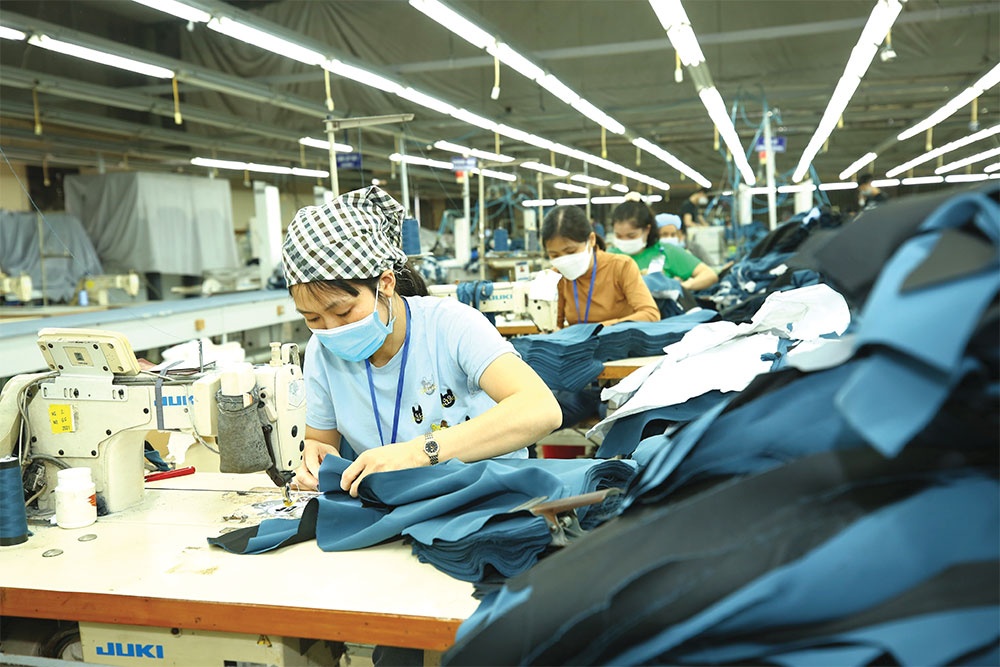Apparel groups anticipate ongoing rocky progress
 |
| Companies are being encouraged to diversify their markets, photo Le Toan |
Consumption of garments is anticipated to increase in the third quarter, but the market has shown no indication of an increase in orders. Nguyen Xuan Duong, chairman of Hung Yen Garment Corporation, stated that an increasing number of businesses are requiring small orders and fast delivery times.
“Even large-scale businesses must receive orders for 500–700 garments to maintain production and retain employees,” he said.
The profits of garment manufacturers plummeted due to a significant decline in processing costs. According to Duong, many products are up to 50 per cent off. Shirt processing costs are now only 70-80 cents per shirt, a significant decrease from $1.70-1.80 per shirt a year ago.
Last week, Truong Van Cam, general secretary of the Vietnam Textile and Apparel Association (VITAS), told VIR that the economic downturn has reduced demand for apparel. However, the reopening of China in January is also viewed as a factor, resulting in shifts in the supply of many existing buyers.
According to data from the Bangladesh Export Promotion Bureau, Bangladesh’s turnover has been declining since March, falling 15.5 per cent year-over-year in April, and there is a shortage of orders for August and the end of the year.
“China has regained its leading position in global garment exports due to its scale and financial privileges as well as government backing through policies that foster economic development based on export, investment, and consumption,” Cam said.
Globally, textile and garment exporting nations rely on their competitive advantages to obtain orders. Bangladesh is fostering price competition by virtue of its low-cost and greening achievements, which were implemented beginning in 2021. The average compensation for Bangladeshi garment labourers is only $95 per person per month, which is significantly lower than that of Vietnam’s $300.
Due to the moderate cost of labour and the fact that the minimum wage is only $95 per month per person, India is a popular destination for many clients. The Indian textile industry possesses a relatively comprehensive supply chain, including cotton, fibres, fabric, apparatus, and technology.
In the meantime, many Vietnamese textile and apparel manufacturers are concerned about the incremental erosion of their competitiveness. According to Le Tien Truong, chairman of the Vietnam National Textile and Garment Group (Vinatex), enterprises will lose “at least 15 per cent if they sustain low unit prices” in order to compete with Bangladesh.
According to Truong’s observations, Vietnam’s textile and garment decline was greatest because the currency was 20 per cent higher in value than competing countries. Concurrently, interest rates in Vietnam were anchored at a high level of 9-11 per cent per year in the first four months of this year, whereas they remain at 3.5–7 per cent in other countries. Moreover, a 3 per cent rise in electricity costs increases the pressure on textile manufacturers.
Since the fourth quarter of last year, Vietnam’s textile and garment exports have continued to decelerate, with five-month exports reaching only $12.32 billion, down 17.8 per cent on-year, indicating that the dearth of orders is unlikely to subside soon.
According to VITAS, a few companies utilising the solution to diversify markets and products have orders through October, while the majority of companies are still seeking orders for July and August. This causes many businesses to anticipate that the bleak market environment will continue into next year, in Vietnam and beyond.
| Vinatex predicts that in the remaining months of 2023, the textile and garment markets will continue to encounter many challenges. In the scenario of global economic decline with no recession, the total demand for textiles and apparel is projected to be around $700 billion, which is lower than in 2020, due to the absence of demand for protective clothing. In the event of a global recession, the total demand for textiles and apparel will be approximately $650 billion, a decline of approximately 13 per cent (or $100 billion) from 2022 levels. |
| Textiles and garments must satisfy importer needs 70,000 garment and textiles job cuts since January |
What the stars mean:
★ Poor ★ ★ Promising ★★★ Good ★★★★ Very good ★★★★★ Exceptional
Related Contents
Latest News
More News
- Businesses ramp up production as year-end orders surge (December 30, 2025 | 10:05)
- Vietjet chairwoman awarded Labour Hero title (December 29, 2025 | 13:06)
- How to unlock ESG value through green innovation (December 29, 2025 | 10:03)
- AI reshapes media and advertising industry (December 29, 2025 | 08:33)
- FPT and GELEX sign deal to develop blockchain tech for global markets (December 29, 2025 | 08:29)
- Vietnam’s GDP forecast to grow by 9 per cent in 2026 (December 29, 2025 | 08:29)
- Women entrepreneurs are key to Vietnam’s economic growth (December 29, 2025 | 08:00)
- Vietnam's top 500 value-creating enterprises announced (December 27, 2025 | 08:00)
- The PAN Group shaping a better future with ESG strategy (December 26, 2025 | 09:00)
- Masan Consumer officially lists on HSX, marking the next phase of value creation (December 25, 2025 | 13:20)

 Tag:
Tag:





















 Mobile Version
Mobile Version